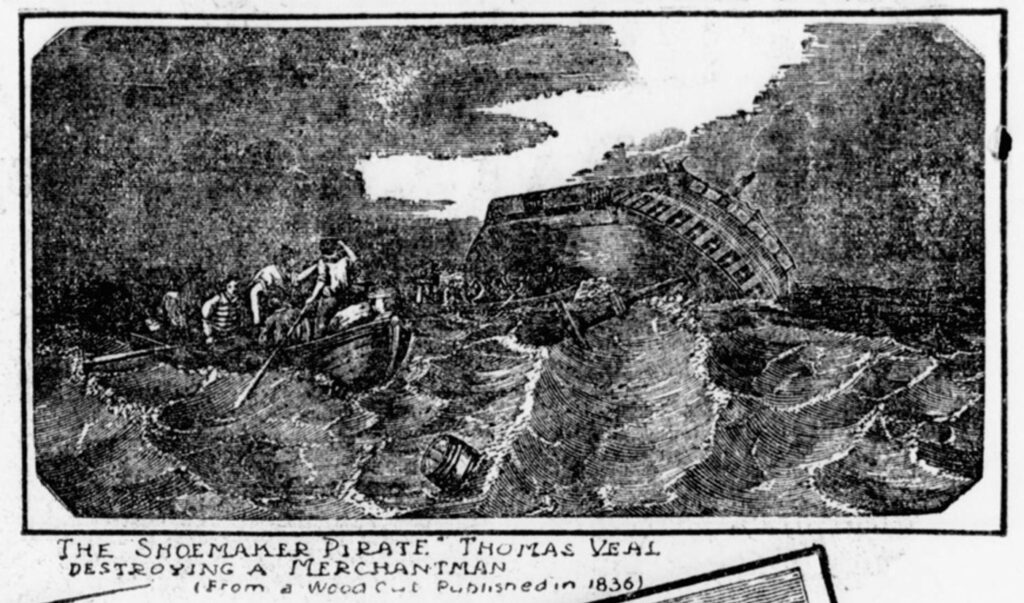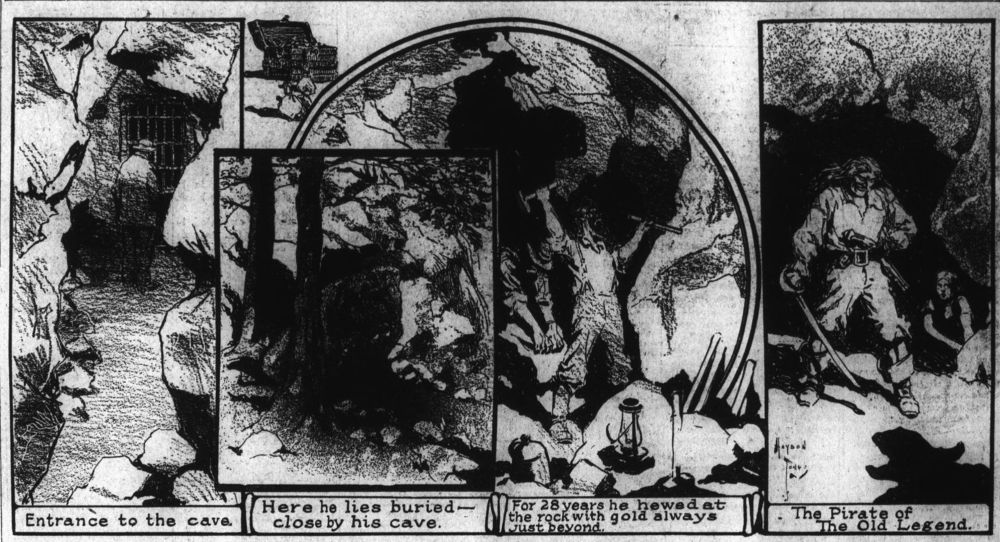Thomas Veale was a pirate who was reportedly buried alive with his treasure in a cave in Dungeon Rock in Lynn, Massachusetts, in 1658.
According to a book published in 1829, The History of Lynn by Alonzo Lewis, Thomas Veale (whose name is also sometimes spelled Veal) was hiding out from the authorities in the cave when an earthquake struck and buried him alive.
Although not much is known about Veale, some sources say that he was born near Salem, Massachusetts, and became a mariner at a young age. He later fell in with some pirates that were scouring the West Indian seas.
After several years of pirating, Veale and his fellow pirates returned to New England to retire and enjoy their plunder. Legend says that locals in Lynn, Massachusetts, saw their pirate ship anchor off the coast one evening in 1658 and watched as they rowed up the river in a small boat before landing and disappearing into the Lynn Woods.
The following morning, the pirate ship was gone. The pirates returned, though, four months later and built a small hideaway in a deep valley called Pirate’s Glen in the Lynn Woods. They hid out there for a while until they were discovered by authorities, and three of them were arrested and sent to England.
Veale reportedly managed to evade the authorities and escaped to Dungeon Rock, which is about two miles inland, where it is believed they had previously hidden their treasure, which was said to contain jewels, trinkets, and silver and gold coins.
Veale lived at Dungeon Rock for a while, even working as a shoemaker, and would occasionally come to town to purchase goods and supplies.
According to an article published in the Kimball Graphic in 1883, on December 14, 1658, a local settler, Joel Dunn, went into the Lynn Woods to cut wood but got caught in a storm and sought refuge with Veale in his nearby cave.
Veale reportedly welcomed the man, built a fire, and cooked supper for them both. Dunn later described the cave as a double cave, with a large cave toward the front where Veal had his kitchen and work tools and a smaller cave towards the back that he used as sleeping quarters. The two sections were separated by a large leather curtain, according to the news report:
“The walls were grim with smoke, and the floor quite rough in places. In the main part there was a large table of rude workmanship, two or three scraggy tree stumps used for seats, and rough shoemaker’s bench, illy supplied with tools. In one corner stood an old Spanish musket, and near the blackened fireplace were a few broken and otherwise dilapidated cooking utensils. Upon the large table previously mentioned, was a broken earthen dish, a rusty knife, a wooden spoon, a pistol, a dirk, a hatchet, a shoemaker’s hammer, and a few other articles.”
Needing some water for the two men, Dunn went outside to a nearby spring when a sudden flash of lightning struck nearby just as the ground underneath him began to shake. He then heard a crash and soon discovered that the mouth of the cave had collapsed, trapping Veal inside.
In fact, he later discovered the whole town suffered damage, with many houses and chimneys collapsing and the tide even caused a small tidal wave.
What’s interesting about this story is the tools that Dunn reportedly saw in the cave are the same as the ones that spiritualist Hiram Marble later excavated in the cave in the 19th century.
A slightly different version of this story was published in 1886 by author Clarance W. Hobbs in his book Lynn and Surroundings, which states that Dunn found the cave and wandered inside but was attacked by Thomas Veale, who grabbed him by the throat, but the earthquake struck at just that moment, and somehow Dunn made it out alive, but Veal didn’t.
Hobbs added that the men who found Dunn in the woods the next day didn’t believe his story because he was carrying a jug of alcohol, so they thought he was just drunk in the woods all night and he only imagined it.
It is a known fact, though, that a terrible earthquake occurred in New England in 1658, and it did do a lot of damage to the local houses and structures, but it’s not clear if Dunn’s story is true.
In the 1830s, attempts were made to excavate the cave and find the treasure when locals used kegs of black powder to blast the rock, but they ultimately failed to find anything.
In the 1850s, a spiritualist named Hiram Marble and his son Edwin bought the property and spent the rest of their lives excavating the cave, claiming the ghost of Thomas Veale was guiding them, but they also failed to find anything.
Sources:
Hobbs, Clarence W. Lynn and Surroundings. Lewis & Winship, 1886.
Lewis, Alonzo. History of Lynn. G.C. Herbet, 1890.
“Confessions of a Lover of Romance.” Atlantic Monthly, vol. LXXX, Houghton, Mifflin and Company, pp. 281-288.
“Pirate’s Buried Treasure.” The Kimball Graphic, 17 Aug. 1883, p. 3.
“Buried Treasure.” The Boston Post, 4 Nov. 1906, p. 32.
“Thomas Veal, The Pirate of Lynn.” Daily Evening Item, 25 Mar. 1904, p. 13.


